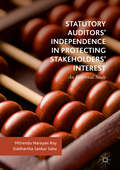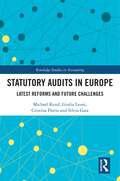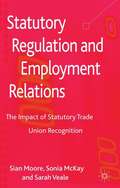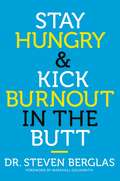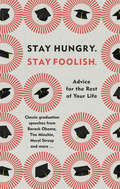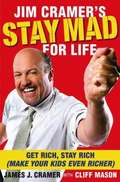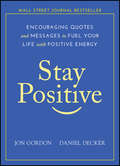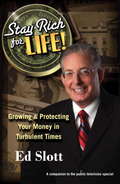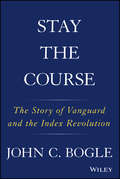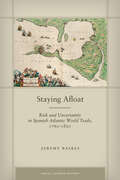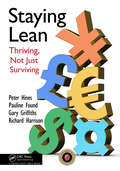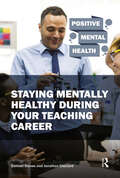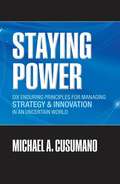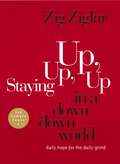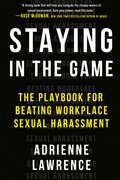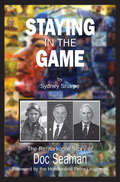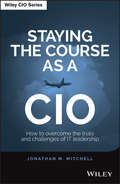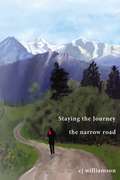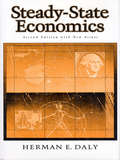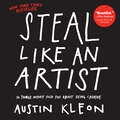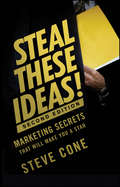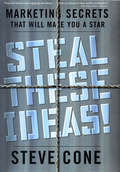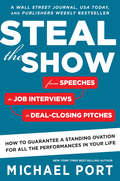- Table View
- List View
Statutory Auditors’ Independence in Protecting Stakeholders’ Interest: An Empirical Study
by Mitrendu Narayan Roy Siddhartha Sankar SahaCorporate failures and accounting scandals have shaken the foundations of investors’ confidence in the transparency, integrity and accountability of corporations and financial markets. There have also been public disquiet about the role of professional auditors and audit firms, who had been associated with these corporate scandals. Written from a global perspective, the book assists in understanding the gravity of independent attitude of statutory auditors in protecting stakeholders’ interest and examines the effectiveness of the existing standards and other legal and regulatory requirements in enforcing statutory auditors’ independent engagement. It then suggests modifications in those regulations. The study has been made through seven chapters in order to address empirically statutory auditors’ independence in protecting stakeholders’ interest. Primary audiences of the book are researchers in finance and control, students, and professionals in the field of accounting and auditing.
Statutory Audits in Europe: Latest Reforms and Future Challenges (Routledge Studies in Accounting)
by Cristina Florio Michael Kend Giulia Leoni Silvia GaiaIn the aftermath of the Global Financial Crisis, corporate collapses, accounting scandals, and concerns around competition and auditor choice, the European Commission (EC) promoted the preparation of various reports on audit policy to support a harmonisation process of European auditing regulation. Consequently, the European Union (EU) Audit Regulation and Directive was implemented from 2016. This book provides a timely picture of the audit sector and how it responds to regulatory and technological challenges. It analyses the impact of EU reforms on audit practices by comparing the UK and Italy, which, representing two very different regulatory and cultural contexts, will offer insight into how the efforts at standardising audit regulation may lead to very different organisational firm responses within Europe. It addresses issues relating to public policy work and the concerns faced by the market for audit and assurance services, in promoting audit quality, better communication about the role of the auditor, capital market stability and confidence, and auditor independence. Moreover, it highlights what the future of auditing might look like in the EU particularly now that the UK has left, and how meeting public expectations will continue to be a struggle for the accounting profession given the many problems ahead. The book encourages a deeper awareness of the challenges faced by those that monitor and certify the financial statements of the world’s largest public companies and contributes to the general understanding of this controversial industry. It will serve as a useful guide to the recent EU audit reforms, not only for academics, and research students but also to regulators, policymakers, standard setters, industry professionals, and business executives worldwide.
Statutory Regulation and Employment Relations
by Sian Moore Sonia Mckay Sarah VealeA comprehensive socio-legal evaluation of the 2000 statutory recognition procedure over ten years of its operation. Whilst exploring its implications for the so-called UK 'voluntarist' approach to regulating industrial relations, the authors argue that the effectiveness of the procedure was constrained by its design.
Stay Connected to Your Purposes: Tuning in to the Motivations that Inspire and Energize the Practice of Adaptive Leadership
by Alexander Grashow Marty Linsky Ronald HeifetzThere is no reason to shoulder the difficult work of adaptive leadership if you do not have compelling, higher purposes to serve, whether saving the world, renewing your organization, or helping your community meet longstanding challenges and thrive through tough times. Your purposes provide the inspiration and the direction for your actions. This chapter describes five practices to help you keep your purposes alive as you lead adaptive change. This chapter was originally published as chapter 19 of "The Practice of Adaptive Leadership: Tools and Tactics for Changing Your Organization and the World."
Stay Hungry & Kick Burnout in the Butt
by Marshall Goldsmith Steven BerglasOne of the foremost authorities on career guidance, Dr. Steven Berglas shows you how to find passion and renewed energy through your work.Most Americans today are frustrated that no matter how much emotional currency they invest in the work they are trying to do well, each day leaves them disappointed, depleted, and distressed. Dr. Berglas has spent more than 25 years studying this phenomenon while a faculty member at Harvard Medical School's Department of Psychiatry, and as an Adjunct Professor at USC's Marshall School of Business. He has devoted four decades to helping high-earning clients derive psychological rewards from work. Berglas' clients range from CEOs and other C-Level executives, to professional athletes, lawyers, politicians, and artists.In STAY HUNGRY & KICK BURNOUT IN THE BUTT, Berglas explores what causes people to suffer psychological burnout , and how to prevent it. Specifically, Berglas walks you through a program that enables you to identify passions and harness the energy (already within you) to fuel psychologically gratifying professional pursuits. Debunking common myths, Dr. Berglas knows there's no one-size-fits-all solution to any psychological problem, which is why he will help you identify your core passion and then offer clear, actionable advice on how to harness it to live a happier and more fulfilling life guided by purpose.
Stay Hungry. Stay Foolish.: Advice for the Rest of Your Life - Classic Graduation Speeches
by Wh AllenGive it your all. Dare to be all you can be.Graduation day is a pivotal moment. After a lifetime of learning, and at least three years of studying hard in a chosen subject, we are thrown headfirst into the unknown world of adulthood. That day – and the months afterwards – are ripe with possibility. They can feel by turns thrilling and rudderless, dreamy and terrifying. It’s the perfect time to reflect on the past and look at what’s to come.In this collection of carefully curated speeches, hear from leading voices such as Barack Obama, Gloria Steinem and Tim Minchin, and discover their profound advice for the graduating classes of Harvard, Stanford and many more top-class universities, who have gone on to shape the world we live in. Whether you’re looking for the perfect graduation gift, a memento of this significant life moment, or are simply seeking guiding inspiration, the lessons in Stay Hungry, Stay Foolish will last a lifetime.
Stay Mad for Life: Get Rich, Stay Rich (Make Your Kids Even Richer)
by James J. CramerJim Cramer, bestselling author and host of CNBC's Mad Money, has written the ultimate guide to lifetime investing for readers of any age. Whether you're a recent college grad trying to figure out how to start investing, a young parent struggling to decide where and how to put away money, or someone well into middle age and worried about whether you've saved enough for retirement,Jim Cramer's Stay Mad for Life has the answers. Cramer covers all the essentials: how to save, where to invest, which pitfalls to avoid. He offers valuable advice on everything from mortgages to college tuition. He explains what professional money managers do right that amateur investors do wrong. Because there is always a bull market somewhere, Cramer tells readers where to find the bull markets of the future, and for those willing to do the homework, he chooses twenty stocks that could be long-term moneymakers. For those who don't have the time or the temperament to invest in stocks, he identifies the mutual funds that are proven winners. He's investigated these funds by using his own twenty-five years' experience managing money for himself and dozens of America's wealthiest families. Throughout, in addition to his own enormously successful experience, Cramer draws on rigorous research to back up his advice. Jim Cramer is America's #1 financial guru. Every day he advises investors on how to get ahead of the markets and stay ahead on his daily television show,Mad Money; in his online columns and commentary at TheStreet.com; in his popular "Bottom Line" column in New York magazine, and on television programs from early morning to late night. His books have all been national bestsellers and have helped educate hundreds of thousands of investors about the perils and promises of the financial markets.USA Today called him "the media's most electrifying market pundit," and his legions of fans agree.Jim Cramer's Stay Mad for Life is the definitive money book, a practical, concrete, insightful book of invaluable financial advice that is a joy to read.
Stay Positive: Encouraging Quotes and Messages to Fuel Your Life with Positive Energy
by Jon Gordon Daniel DeckerFuel yourself and others with positive energy—inspirational quotes and encouraging messages to live by from bestselling author, Jon Gordon. Ever since he wrote the mega bestseller The Energy Bus, Jon Gordon has been sharing inspirational messages and encouragement via his talks, books, and social media posts. After many requests to create a collection of his quotes, Jon teamed up with his long-time friend, Daniel Decker, to create Stay Positive. Stay Positive is more than a book of positive quotes. This book is a resource you can turn to each day for encouragement to help you take on your daily challenges, pursue your goals and dreams, and create positive momentum in your life. The power of positive thoughts is not about being Pollyanna Positive; it’s the real stuff that makes a proven difference in your perspective and life. After all, we don’t give up because it’s hard; we give up because we get discouraged. By fueling yourself with encouragement and positive energy, you’ll have greater power to overcome negativity, neutralize the naysayers, and conquer adversity. Stay Positive is more than a phrase. It’s an approach to life that says when you get knocked down, you'll get back up and find a way forward one faithful step and optimistic day at a time. Start your day with a message from the book, or pick it up anytime you need a mental boost. You can start from the beginning, or open the book to any page and find a message that speaks to you. However you decide to use Stay Positive, it’s a go-to resource for anyone wanting to inject a healthy dose of positivity into their life.
Stay Rich For Life!
by Ed SlottTo coincide with his new public television special, airing on PBS stations starting in March 2009, Ed Slott’s proven plan for generating enough personal wealth to last you the rest of your life Given the challenging economic times, we will all welcome Ed Slott’s concrete advice for generating enormous wealth. In this must-have book you’ll learn how to: • Retire with more money than you ever could have imagined and still take care of your loved ones • Move your money from FOREVER taxed to NEVER taxed • Make your IRA and 401(k) safer during rocky periods • Pick the best financial advisor and learn what pitfalls to avoid • Think and plan like a multimillionaire • Make Uncle Sam work for you Based on Slott’s fundamental principles of building, protecting, and preserving wealth for you and your loved ones,Stay Rich for Lifeis filled with real life stories.
Stay Rich for Life!: Growing & Protecting Your Money in Turbulent Times
by Ed SlottTo coincide with his new public television special, airing on PBS stations starting in March 2009, Ed Slott’s proven plan for generating enough personal wealth to last you the rest of your life Given the challenging economic times, we will all welcome Ed Slott’s concrete advice for generating enormous wealth. In this must-have book you’ll learn how to: • Retire with more money than you ever could have imagined and still take care of your loved ones• Move your money from FOREVER taxed to NEVER taxed• Make your IRA and 401(k) safer during rocky periods• Pick the best financial advisor and learn what pitfalls to avoid• Think and plan like a multimillionaire• Make Uncle Sam work for youBased on Slott’s fundamental principles of building, protecting, and preserving wealth for you and your loved ones, Stay Rich for Life is filled with real life stories.
Stay the Course: The Story of Vanguard and the Index Revolution
by John C. BogleA journey through the Index Revolution from the man who started it all Stay the Course is the story the Vanguard Group as told by its founder, legendary investor John C. Bogle. This engrossing book traces the history of Vanguard—the largest mutual fund organization on earth. Offering the world’s first index mutual fund in 1976, John Bogle led Vanguard from a $1.4 billion firm with a staff of 28 to a global company of 16,000 employees and with more than $5 trillion in assets under management. An engaging blend of company history, investment perspective, and personal memoir, this book provides a fascinating look into the mind of an extraordinary man and the company he created. John Bogle continues to be an inspiring and trusted figure to millions of individual investors the world over. His creative innovation, personal integrity, and stubborn determination infuse every aspect of the company he founded. This accessible and engaging book will help you: Explore the history of some of Vanguard’s most important mutual funds, including First Index Investment Trust, Wellington Fund, and Windsor Fund Understand how the Vanguard Group gave rise to the Index Revolution and transformed the lives of millions of individual investors Gain insight on John Bogle’s views on values such as perseverance, caring, commitment, integrity, and fairness Investigate a wide range of investing topics through the lens of one of the most prominent figures in the history of modern finance The Vanguard Group and John Bogle are inextricably linked—it would be impossible to tell one story without the other. Stay the Course: The Story of Vanguard and the Index Revolution weaves these stories together taking you on a journey through the history of one revolutionary company and one remarkable man. Investors, wealth managers, financial advisors, business leaders, and those who enjoy a good story, will find this book as informative and unique as its author.
Staying Afloat: Risk and Uncertainty in Spanish Atlantic World Trade, 1760-1820
by Jeremy BaskesEarly modern, long-distance trade was fraught with risk and uncertainty, driving merchants to seek means (that is, institutions) to reduce them. In the traditional historiography on Spanish colonial trade, the role of risk is largely ignored. Instead, the guild merchants are depicted as anti-competitive monopolists who manipulated markets and exploited colonial consumers. Jeremy Baskes argues that much of the commercial behavior interpreted by modern historians as predatory was instead designed to reduce the uncertainty and risk of Atlantic world trade. This book discusses topics from the development and use of maritime insurance in eighteenth- century Spain to the commercial strategies of Spanish merchants; the traditionally misunderstood effects of the 1778 promulgation of "comercio libre," and the financial chaos and bankruptcies that ensued; the economic rationale for the Spanish flotillas; and the impact of war and privateering on commerce and business decisions. By elevating risk to the center of focus, this multifaceted study makes a number of revisionist contributions to the late colonial economic history of the Spanish empire.
Staying Lean: Thriving, Not Just Surviving, Second Edition
by Peter Buckley Pauline Found Glynn Harrison Gary GriffithsThe first edition of this highly acclaimed publication received a Shingo Research and Professional Publication Prize in 2009. Explaining how to create and sustain a Lean business, it followed Cogent Power‘s first two Lean Roadmaps along their journey. Since then, much has changed. Several members of Cogent Power‘s senior management have moved on, s
Staying Mentally Healthy During Your Teaching Career (Positive Mental Health)
by Jonathan Glazzard Samuel StonesThe mental health of teachers in school is just as important as the well-being of the pupils they support. Recent research reveals some alarming statistics, including that 74% of teachers are unable to relax and have a poor work-life balance. This book examines a range of relevant issues including workload, managing behaviour, developing resilience and managing professional relationships in order to address some of these concerns and provide comprehensive guidance and workable, evidence-informed strategies to support all those teaching in schools and colleges.
Staying Power: Six Enduring Principles for Managing Strategy and Innovation in an Uncertain World (Lessons from Microsoft, Apple, Intel, Google, Toyota, and More), First Edition
by Michael A. CusumanoWhat enables businesses to succeed over the long haul and through changes in markets and technologies? Drawing on 30 years' research into some of the world's most successful companies, Cusumano distills six fundamental principles to equip business to survive and thrive in today's rapidly-changing markets.
Staying Up, Up, Up in a Down, Down World: Daily Hope for the Daily Grind
by Zig ZiglarThe daily grind can be exhausting-both physically and mentally. Motivational speaker Zig Ziglar offers this devotional as an antidote to "jump start" your day! You can face each weekday morning with a power-packed message and end the day with encouraging words that will promote restful sleep. Full of motivation and inspiration, Staying Up, Up, Up in a Down, Down World is a combination of inspiring vignettes, humorous anecdotes, well-chosen quotes, and relevant Scriptures. Don't allow yourself to be dragged down by day-to-day trials; instead, allow the positive words of Ziglar to lift you up each day.
Staying in the Game: The Playbook for Beating Workplace Sexual Harassment
by Adrienne LawrenceA practical guide to shutting down workplace sexual harassment so it doesn't derail your career or your life, from the first on-air personality to sue ESPN for sexual harassment."A strong book that will help you navigate the choppy waters of sexual harassment. Gain your power, read this book."-Rose McGowan, New York Times bestselling author of BraveEven in the #MeToo era, studies show that women in the workforce continue to harbor misconceptions about sexual harassment and are unprepared to respond when it happens. Lawyer and former ESPN anchor Adrienne Lawrence has learned to advocate for herself and other women. In this book, she offers much-needed insight on topics such as: • Identifying the five types of harassers and the five types of coworkers who enable them • Researching company culture and history to identify sexual harassment hotbeds • Properly documenting inappropriate behavior • Preparing for retaliation and mental health hurdles such as anxiety and depression • Managing public exposure and figuring out when to leverage the power of the media and/or lawyer upThis essential guide helps women navigate the complicated realities of sexual harassment and teaches them how to be their own best advocates in toxic work environments.
Staying in the Game: The Remarkable Story of Doc Seaman
by Sydney SharpePeter C. Newman called him "the Totem of the Titans." From a small Prairie town, Daryl K. "Doc" Seaman became an icon of Canadian business and hockey. He is one of the last of a breed of postwar entrepreneurs and sportsmen who forged modern Canada, striking deals on a handshake and always keeping their word.After flying 82 combat missions during the Second World War, Doc Seaman worked in the oil industry with his brothers, turning a small Alberta drilling business into a global giant, Bow Valley Industries. Later, he led a group that brought the Atlanta Flames to Calgary. Still a Flames co-owner, he helped reshape Hockey Canada and restore Canada’s glory in international hockey.Doc Seaman’s life is a remarkable saga of courage, resolve, generosity, and success. It ultimately leaves us not only with a deep appreciation of one iconic Canadian but also with a wider understanding of our country.
Staying the Course as a CIO
by Jonathan MitchellSTAYING THE COURSE AS A CIO: HOW TO OVERCOME THE TRIALS AND CHALLENGES OF IT LEADERSHIPThe shelf-life of a Chief Information Officer can be shockingly short. Few survive in post for more than a few years. More often each falls prey to insurmountable problems and their careers come to a sharp and ignominious end. In this book, a global CIO with over thirty years of experience in major corporations examines the main reasons why this happens. Readers will understand which types of issue can cause problems for an IT Leader and more importantly, they will learn strategies of how these problems can be minimized or even avoided.IT is often seen a technical backwater, but it is a discipline which has the capability to add massive value to an organisation whether it is in the private or the public sector - provided of course it has the right leadership doing the right things.Aspiring IT Leaders will need to deal with a common set of recurring trials and challenges. These include:· Overcoming the challenge of managing diverse and conflicting stakeholders· How to deal with large and complex projects· Making sense of software and how to handle the rapidly changing technology landscape· Knowing when to outsource and how to get the best out of an outsourcing partner· Harnessing the intellectual power of consultants to help you meet your goals· And last but not least, how to develop a set of strategies that are aligned with your corporate goals and then make sure your resources are properly targetted so that the IT function generates maximum positive impact for the enterprise.For IT professionals looking to fully integrate their function into the enterprise, 'Staying the Course as a CIO' is a valuable source of practical advice, all based on real experience.
Staying the Journey: The Narrow Road
by CJ WilliamsonGiven all of life&’s distractions in this current culture, it is difficult to walk the narrow road. Between the desire to live a comfortable life we often make spiritual sacrifices that are detrimental to our overall spiritual health. Before we know it, we have widened the narrow road beyond recognition. The only problem is God doesn&’t widen His vision of the same road. So, together looking back at heroes of the faith mixed with personal stories of struggle and victory, this book will enhance your ability at staying the journey of the narrow road.
Steady-State Economics: Second Edition With New Essays (Advances In Ecological Economics Ser.)
by Herman E. DalyFirst published in 1977, this volume caused a sensation because of Daly's radical view that "enough is best." Today, his ideas are recognized as the key to sustainable development, and Steady-State Economics is universally acknowledged as the leading book on the economics of sustainability.
Steal Like an Artist: 10 Things Nobody Told You About Being Creative (Austin Kleon)
by Austin KleonYou don’t need to be a genius, you just need to be yourself. That’s the message from Austin Kleon, a young writer and artist who knows that creativity is everywhere, creativity is for everyone. A manifesto for the digital age, Steal Like an Artist is a guide whose positive message, graphic look and illustrations, exercises, and examples will put readers directly in touch with their artistic side. When Mr. Kleon was asked to address college students in upstate New York, he shaped his speech around the ten things he wished someone had told him when he was starting out. The talk went viral, and its author dug deeper into his own ideas to create Steal Like an Artist, the book. The result is inspiring, hip, original, practical, and entertaining. And filled with new truths about creativity: Nothing is original, so embrace influence, collect ideas, and remix and re-imagine to discover your own path. Follow your interests wherever they take you. Stay smart, stay out of debt, and risk being boring—the creative you will need to make room to be wild and daring in your imagination.
Steal These Ideas!
by Steve ConeWorking for nearly thirty years with and for leading companies including Citigroup, American Express, Epsilon, Apple, and Fidelity--with notable political and not-for-profit campaigns along the way--Steve Cone has the kind of hard-earned, high-level experience that translates into valuable, tested ideas on what really works--and doesn't--in marketing.In Steal These Ideas! Cone delivers hundreds of pearls in a sharp, no-nonsense, and witty style on all facets of marketing, branding, and advertising with all the candor and freshness one would expect from a knowledgeable good friend in the business.Illustrated throughout with examples of the good, bad, and ugly in advertising, this is the secret stuff that no one ever teaches. Anyone can now steal these ideas and become a marketing star today.
Steal These Ideas!: Marketing Secrets That Will Make You a Star (Bloomberg #25)
by Steve ConeWorking for nearly thirty years with and for leading companies including Citigroup, American Express, Epsilon, Apple, and Fidelity—with notable political and not-for-profit campaigns along the way—Steve Cone has the kind of hard-earned, high-level experience that translates into valuable, tested ideas on what really works—and doesn’t—in marketing. In Steal These Ideas! Cone delivers hundreds of pearls in a sharp, no-nonsense, and witty style on all facets of marketing, branding, and advertising with all the candor and freshness one would expect from a knowledgeable good friend in the business. Illustrated throughout with examples of the good, bad, and ugly in advertising, this is the secret stuff that no one ever teaches. Anyone can now steal these ideas and become a marketing star today.
Steal the Show
by Michael PortAn inspiring program full of essential advice for spotlight lovers and wallflowers alike that will teach readers how to bring any crowd to its feet Every day there are moments when you must persuade, inform, and motivate others effectively. Each of those moments requires you, in some way, to play a role, to heighten the impact of your words, and to manage your emotions and nerves. Every interaction is a performance, whether you're speaking up in a meeting, pitching a client, or walking into a job interview. In Steal the Show, New York Times best-selling author Michael Port draws on his experience as an actor and as a highly successful corporate speaker and trainer to teach readers how to make the most of every presentation and interaction. He demonstrates how the methods of successful actors can help you connect with, inspire, and persuade any audience. His key strategies for commanding an audience's attention include developing a clear focus for every performance, making sure you engage with your listeners, and finding the best role for yourself in order to convey your message with maximum impact. Michael Port is one of the most in-demand corporate speakers working today. His presentations are always powerful, engaging, and inspirational. And yes, audiences always give him a standing ovation.
